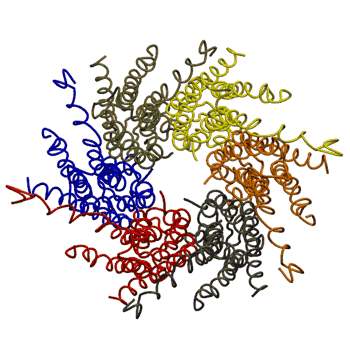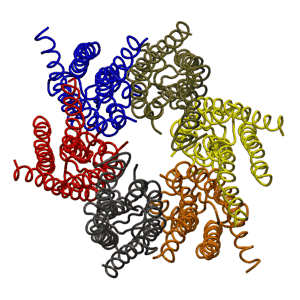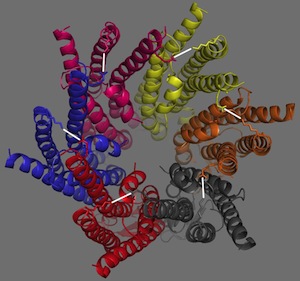Cx26 is a receptor for CO2
In a paper published in eLife, we have elucidated the mechanism by which CO2 binds to Cx26: it carbamylates Lys125 enabling a salt bridge across the intersubunit boundary to Arg104 on the neighbouring subunit, thereby causing the channel to be open more of the time. We call these intersubunit bonds "carbamate bridges" and, since Cx26 is hexameric, 6 of these carbamate bridges can form. The consequences of CO2-binding for the molecular motions of Cx26 are shown in the two movies below -the carbamate bridges trap the hemichannel in the open conformation. This can then allow efflux of ATP and the modulation of physiological processes -for example to increase breathing.


Left: Movie of Cx26 motions without CO2 bound -the helices of the protein can completely occlude the central pore. Right: Molecular motion of Cx26 with CO2 bound, now the helices are unable to occlude the central pore. Cx26 is drawn according to 2zw3, and is seen from the cytoplasmic side. These movies come from Elastic Network Models of Cx26 based on 2zw3 made by Tom Rodgers and Martin Cann of Durham University.
Very recently we have found that the CO2 sensing via Cx26 may also be relevant to the human condition. KID syndrome is a very serious condition that is caused by mis-sense mutations in Cx26. Our collaborators Naveed Hussain and Dan Mulkey in Connecticut identified an infant with KID syndrome, suffering from periods of central apnea, carrying the A88V mutation. In our latest paper in eLife we found that this mutation completely removes the CO2 sensitivity of Cx26 and acts in a dominant negative fashion. This suggests that CO2 sensing via Cx26 may be important for human breathing and even play roles in the other physiological systems that are affected in KID syndrome -skin and cochlea.

